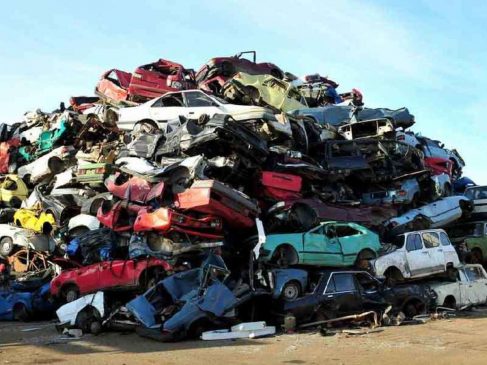The government’s new Vehicle Scrappage Policy has laid down comprehensive guidelines about how old vehicles in the country will be scrapped or discarded. Under this new policy, government and commercial vehicles older than 15 years and private vehicles older than 20 years will be scrapped or destroyed.
NEW DELHI: Earlier this year in March, Union Transport Minister Nitin Gadkari had announced the much-awaited Vehicle Scrappage Policy in the Lok Sabha. Gadkari then said that the policy, which is touted as a top measure to boost the Indian automobile sector, will help in reducing pollution and increase road safety.
The policy was first announced by the Union Finance Minister Nirmala Sitharaman on February 1.
What is the Vehicle Scrappage Policy?
The government’s new Vehicle Scrappage Policy has laid down comprehensive guidelines about how old vehicles in the country will be scrapped or discarded. Under this new policy, government and commercial vehicles older than 15 years and private vehicles older than 20 years will be scrapped or destroyed.
Under the scrappage policy, old vehicles will have to pass a fitness test before re-registration and, as per the policy, government commercial vehicles more than 15 years old and private vehicles which are over 20 years old will be scrapped.
The government also proposed that all vehicles of the central government, state government, municipal corporation, panchayats, state transport undertakings, public sector undertakings and autonomous bodies with the Union and state governments may be de-registered and scrapped after 15 years from the date of registration. The tentative date for scrappage of government and PSUs vehicles above 15 years was April 1, 2022.
Testing of old vehicles under the scrappage policy
Old vehicles will be tested at the Automated Fitness Center and the fitness test of the vehicles will be conducted according to international standards. Emission test, braking system, safety components will be tested and the vehicles which fail in the fitness test will be scrapped.
The rules for creating Fitness Test and Scrapping Centers will come into effect from October 1, 2021 while the scrapping of vehicles of 15-year-old government and PSUs will start from April 1, 2022 and heavy vehicles from April 1, 2023.
The fitness test will be made mandatory for commercial vehicles and from June 1, 2024, the fitness test will be made mandatory for all other categories of vehicles in a phased manner.
Why is scrappage policy important?
The new scrappage policy is important because older vehicles exert 10 to 12 times more pollution than fitted vehicles and are a bigger threat to road safety. Currently, there are around 51 lakh light motor vehicles in India which are more than 20 years old and there are 34 lakhs vehicles that are more than 15 years old. There are about 17 lakh medium and heavy commercial vehicles that are more than 15 years old and operating without the required ‘Fitness Certificate’.
How will this policy benefit vehicle owners?
Under the scrappage policy vehicle owners while buying a new vehicle will get a rebate of 4 to 6 per cent off the total price. Apart from this, the state governments may be advised to offer a road-tax rebate of up to 25% for personal vehicles and up to 15% for commercial vehicles. Vehicle manufacturers will also give a discount of 5% to people who will produce the ‘Scrapping Certificate’ and registration fees will be waived off on the purchase of a new vehicle.
Another advantage of this policy is that scrap materials will get cheaper and that will reduce the production cost of the vehicle manufacturers. It also estimated to provide employment to about 3 crore 70 lakh people in the automobile sector.
In the new fitness centers, 35 thousand people will get employment and an investment of Rs 10,000 crores will be pumped in. The government treasury is expected to get around Rs 30,000 to 40,000 crores of money through GST from this policy.
As per these guidelines, scrapping centres will only be allowed to be set up in industrial areas and not in busy, residential areas. Moreover, permission from the state transport department will be required for the scrapping centre and the owner will need to furnish an earnest money deposit (EMD), proposed to be between Rs 10 lakh to Rs 1 crore, to state governments.
Scrapping of old vehicles: What’s the process?
Scrapping an old vehicle is one of the safest options available than selling or transferring the old vehicle to some other state. This ensures that the car is chopped into pieces and recycled. This will also prevent the chances of its unauthorised use.
-As per the govt guidelines, before scrapping an old vehicle, its chassis number should be removed before it is sent for recycling.
-The vehicle owner should approach an authorised scrap dealer for scrapping.
-It is the duty of the dealer to ensure that the vehicle is disposed of in a safe manner without causing a negative impact on the environment.
-The vehicle owner should also inform the authorised local RTO office that his old vehicle has been duly scrapped.
-He can also deregister his old vehicle.
-The scrap dealer is required to do a physical inspection of the old vehicle and quote a price for scrapping based on its weight and other details.
-If the vehicle owner agrees to the price quoted by the dealer, he will give his consent for removing the car parts and segregating them into rubber, plastic, iron, etc.
-The vehicle owner can also negotiate on the price for different car parts, such as the battery, tyres, etc. This will, however, depend on the condition of these parts as well. In the case of a CNG-fitted vehicle, the owner can ask for a different price for the same.
-The vehicle owner should check whether the car has actually been scrapped by the scrap dealer. It is possible that the scrap dealer does not really scrap the vehicle, and then it may be used for illegal activities. This could invite trouble for the original car owner since the vehicle is registered in his name.
-It is also not mandatory to submit the original RC to the scrap dealer. A photocopy of the RC can be given.
-The vehicle owner should take photos of the scrapped car as evidence for further procedures at the RTO.
-If the vehicle is not in working condition, the owner is not likely to get a good price for metal parts.
-If it is in good shape, the scrap dealer can sell the spare parts at a good price. Only the metallic body of the car should be scrapped.
Rules for scrapping and deregistration of old vehicles
-The vehicle owner will have to first inform the authorised local RTO office about the vehicle scrapping.
-He/She will have to surrender the original RC of the vehicle along with the chassis number that was removed from the vehicle at the time of scrapping.
-The RTO office will keep this as part of the vehicle’s records.
-A confirmation by the scrap dealer on letterhead with complete address is also required. The pictures of the scrap can be submitted at this time.
-The vehicle owner should also submit an affidavit with the application for scrap and de-registration. -The affidavit should also mention that the car is not under any loan, insurance claims, or pending court cases. It should also mention that the vehicle is not involved in crime, thefts etc in the affidavit.
-The RTO will then verify the documents and proceed with the next steps after it receives diligence reports from the traffic police and National Crime Records Bureau (NCRB).
-The RTO will also verify the records of the vehicle maintained at the RTO database regarding sale or purchase of the car. If all records are found to be satisfactory, the car will be deregistered by the RTO.



































